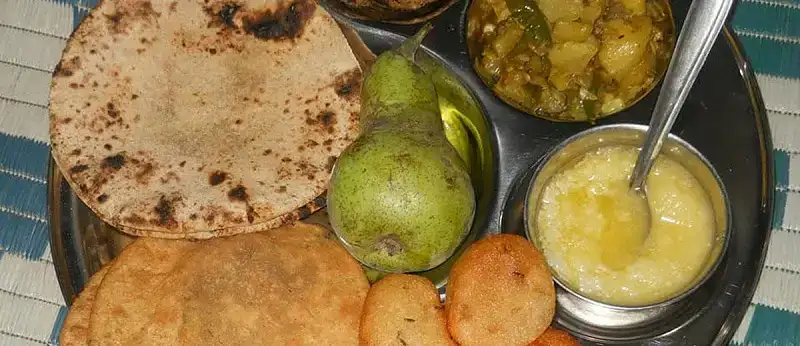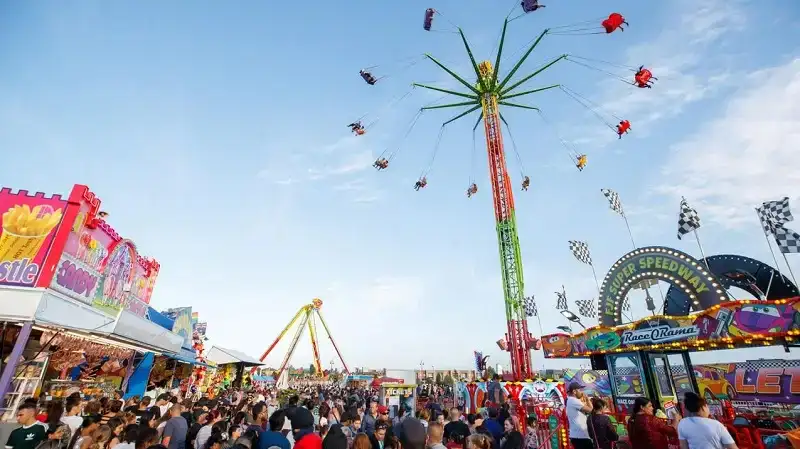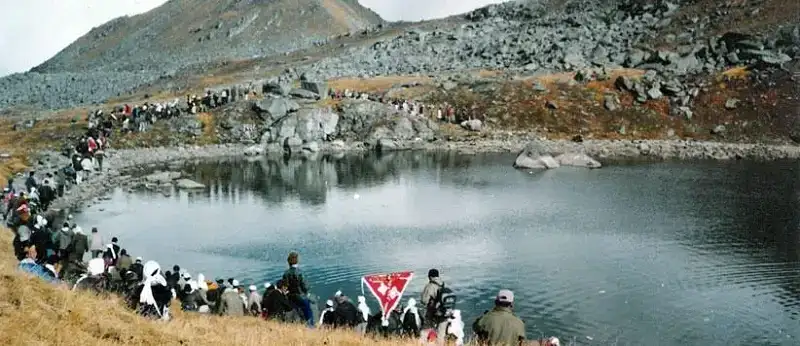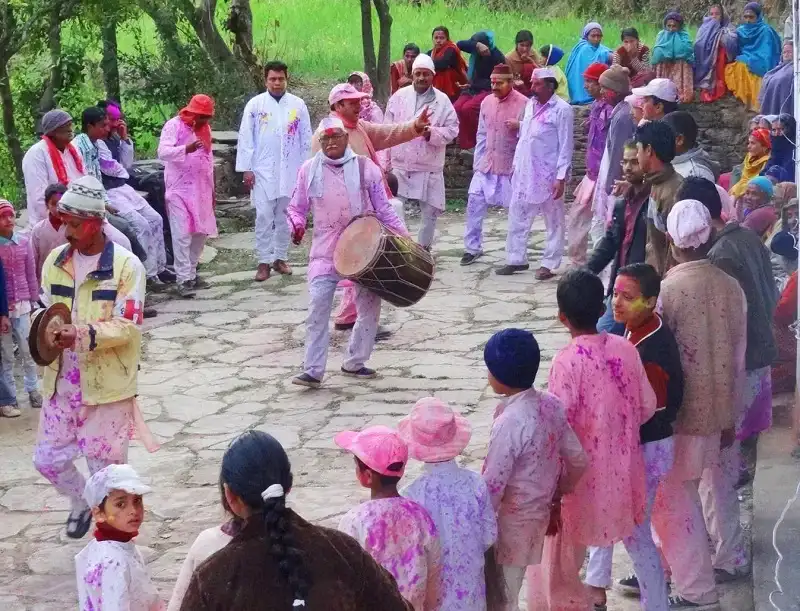Mysterious, exotic, and charming, these words would perfectly describe Uttarakhand. It is popularly known as “Devbhumi” meaning abode of Gods. Most of the festivals celebrated here are associated with nature and seasonal changes. Let us have a look at a few of the festivals celebrated here.
Uttarakhand
1) Phool Dei
Phool Dei is the harvest festival of Uttarakhand and is celebrated to thank God for a good crop year. It welcomes the spring season. Little girls decorate the entrance of their houses with freshly picked flowers. Placing flowers at the entrance of homes is believed to bring prosperity and blessings. Girls go together to every house in their village or town and give plates of rice, coconut, green leaves, flowers, and jaggery. They are blessed and given small gifts in return. On the last day, flowers of a minimum of 5 different colors adorn every doorstep. “Dei” means a special pudding made of jaggery and is of utmost importance during the festival. This festival shows the bonding between communities and teaches generations to value bounty of nature.
When– March- April
Where– Garhwal and Kumaon regions
Experience– The entire state is covered with different flowers and each house is beautifully decorated. Anyone visiting during this time is offered dei to relish. Local people sing and dance to folk songs while exchanging wishes.

Little children celebrating Phool Dei. Photo credit:timesofindia.indiatimes.com
2) Harela
Harela festival marks the start of the sowing cycle of crops. It means ‘day of green’ A few days before the celebration, seeds of five to seven grains like maize, mustard, barley, wheat, rice, horse gram, and soyabeans are mixed and sown in a pot. It is kept in a room where light does not come in and sprinkled with water 2-3 times a day. These are harvested on the 9th day and distributed to friends, neighbors, etc. Germination of the plant predicts how the harvest season will be. Harela is celebrated to welcome the rains and celebrate the wedding anniversary of Lord Shiva. Clay statues of Shiva and Parvati are made before the festival and worshipped on that day. This festival brings happiness, peace, and prosperity to the family.
When-July 16
Where– Kumaon regions
Experience– Songs are sung in the Kumaoni language and everyone has a good time. Delicious meals are prepared. The traditional way of celebrating with germination of seeds is seen more in villages.

Sprouted seeds during Harela celebrations in Uttarakhand. Photo credit: haridwarrishikeshtourism.com
3) Ghee Sankranti/Olgia
Ghee Sankranti demonstrates gratitude for agricultural prosperity and marks the start of the harvesting season. Traditionally, sons-in-law and nephews would gift their father-in-law and uncles, respectively. Today, agriculturists and artisans give gifts to land owners and customers. One of the important rituals includes pouring ghee on the foreheads and relishing ghee and chapattis stuffed with urad dal. People also eat arbi vegetable on this day. Legend had it that if a person does not include ghee in their food on this day, they will be reborn as a snail in their next birth.
When– August
Where– Uttarakhand
Experience– People gather at temples and homes to enjoy songs and Jhoda dance. Elders relive memories of the festival from back in the day and pass on invaluable wisdom. Trees are laden with fruits, and there is greenery everywhere. It is truly a happy time.

Meals prepared on ghee sankranti. Photo credit: kafaltree.com
4) Uttarayani Fair
Uttarayani fair is one of the oldest and biggest festivals in Uttarakhand. It is a cultural fair with displays from weavers and locals selling handmade blankets, shawls, carpets, etc. It is famous as the Bhageshwar district fair. Uttarayani fair was a medium to communicate social and political messages to the public since ages. Gandhiji also came to Bhageshwar to give the call for freedom. Thus it was an important fair during India’s freedom fight. Local artists perform to highlight the cultural heritage of the place. Cholliya dancers perform to the local Kumaoni music, while Jhoras is a dance form by a group of women. It is a way to revive the local culture.
When– January
Where– Kumaon and Garhwal
Experience– Enjoy dance performances and cultural fairs. One can also shop for local and handmade products. People dress up in vibrant clothes, hence brightening up the spirits. Everyone is joyful during these festival days.

The colorful Uttarayani fair. Photo credit: blog.sterlingholidays.com
5) Chippla Jaat festival
Chippla Jaat festival is a 5-day yatra by Jaat travelers. The folk priest decides the Jaat date. They collect red cloth flags from various villages and then go to Barmano. People gather together and walk to Najurikote in Panchchuli Mountains, where Chippla Kedar temple is. This journey is taken barefoot by many and the walk is through thick forests and rocky lands. On the third day of the yatra, pilgrims dip in the holy lake of Bhramakund that washes away their sins.
When– August, once in 3 years.
Where– Chippla Kote in Pithoragarh district.
Experience– During the festival, there are fairs organized with dance and delicious food. Divine songs are played on drums while people journey barefoot.

Devotees taking the Chippla Jaat yatra. Photo credit: kafaltree.com
6) Budi Diwali
Budi Diwali is a unique tradition celebrated one month after Diwali. The belief associated is that Lord Ram’s homecoming news reached the hills late. It is a 5-day long festival. The uniqueness lies in the fact that this Diwali is without any firecrackers. Food prepared includes fritters from pulses and rice flakes, then distributed to neighbors and friends. On this day, a wooden elephant made by villagers is carried around the village. Gram Pradhan is a part of this march. Buchedu dance is a traditional dance form performed which is associated with the festival. The entire atmosphere is filled with joy.
When– 1 month after Diwali
Where– The Jaunsar Bawar region.
Experience– People dance to folk songs in long chains around a bonfire. Small bundles of twigs of Deodar trees are made and lit from the bonfire. It resembles crackers but without pollution.

Celebration of Budi Diwali with twigs of trees. Photo credit: jayuttarkhandi.com
7) Kumaoni Holi
Kumaoni Holi is a musical event that celebrates the victory of good over evil. It is also the end of winter and the start of the sowing season. There are 3 types of celebrations: Baithki Holi, Khari Holi, and Mahila Holi. Baithki Holi is celebrated mainly in community centers and local homes. Hindustani classical and Kumaoni folk songs with tabla and harmonium are sung at homes and in temples. Khari Holi is standing holi. Adorned in traditional attires, men go from house to house to sing folk songs and celebrate with everyone. Mahila Holi is similar to baithki Holi but is mainly by women. Songs sung are on love and spiritual union. The famous gujiyas are eaten as a delicacy.
When– February-March
Where– Kumaon
Experience– People have fun with colors made of flower extracts. Gulaal is thrown in the air while praying for prosperity. Celebrations continue for a month

People enjoying Kumaoni holi with folk songs. Photo credit: ekumaon.com










